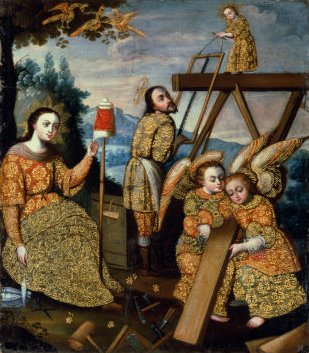 In the Novus Ordo, today is the Feast of the Holy Family. We are also observing Sunday in the Octave of Christmas.
In the Novus Ordo, today is the Feast of the Holy Family. We are also observing Sunday in the Octave of Christmas.
A liturgical “octave” is an eight day period following and including the feast. In a way, the Church suspends time so that we can “rest” within the mystery we have celebrated while contemplating it from different angles.
Perhaps you have gone to a museum and seen a magnificent statue, such as Michelangelo’s David in Florence.
Glancing at it for a moment is not enough; you want to spend some time.
You look at it first from this direction, then another. You walk around it to see it from various points of view.
Considering our human weakness, a single day per year does not suffice to gather in the different dimensions of the mystery of a great feast. An octave allows us to reflect on a feast in different ways.
For example, Pius Parsch, a prominent figure of the Liturgical Movement during the 20th c., wrote in The Church’s Year of Grace that the feasts of Sts. Stephen, John the Evangelist, and the Holy Innocents permit us to approach Christ, the new born King, first as martyrs, then as virgins, then as virgin-martyrs.
Theologically speaking, an octave anticipates the eternal bliss of heaven in which we will consider God in His glory.
Think of it this way. God created the world in six days and on the seventh, the Sabbath, He rested. This cycle of seven repeats itself while the world endures. The eighth day is therefore beyond the cycle of seven. It symbolizes an eternal state, the perfect unending Sabbath of heaven. As a Church, during the octave – perceived as a single continuous day – we imitate the hosts of heaven in their abiding contemplation.
Advent prepared us for the coming of the Lamb, both at Bethlehem and the end of time. Christmas too marks both comings. After Christmas we gather around the manger of Bethlehem and contemplate Jesus who is also the Lamb of the book of Revelation. We are like the Magi who adore Him, but we are also like the heavenly multitude of 144,000 who “follow the Lamb wherever he goes” (Rev 14:4). In both ways we remain in the Lord’s presence.
On 1 January we celebrate the Solemn feast of Mary, Mother of God (in the traditional Roman calendar the Feast of the Circumcision when Christ shed His Blood for us for the first time). Thus, at Christmas the wooden Crib already points to the wooden Cross, and beyond to the goal of heaven made possible now for the children of a common Father. Mary stood at the foot of both.
Consequently, we honor Mary with great solemnity in the Christmas octave. By her participation in the salvific shedding of her Son’s Blood Mary gives us an important example of sacrificial love.
God Incarnate chose to begin manifesting this sacrificial love, which reached its culmination on the Cross, in the family home.
Together with Mary and His earthly father Joseph, Christ began to reveal something of the unity of love within the most perfect of communions, the Holy Trinity.
It is fitting to celebrate the Holy Family within the Octave of Christmas when we contemplate the coming of the Lord in imitation of that final, perfect communion with God to be enjoyed only by the blessed in heaven.
The family is a paradigm of all other human relationships. The Holy Family teaches us, who are still in this world but moving inexorably toward our judgment and final goal, how to live – together – in this present state of “already, but not yet”.


































“God Incarnate chose to begin manifesting this sacrificial love, which reached its culmination on the Cross, in the family home.”
Excellent remarks, Fr. Z, thank you.
A sure reminder why all gnostic down-grading of the ordinary, physical existence–day to day stuff–is the “stuff” that is redeemable, and what has been created out of Love can now find its way back to that same Love.
In other words, The Holy Family slays man-made religions that bypass ordinary life.
Father Z, your statement: The family is a paradigm of all other human relationships. The Holy Family teaches us, who are still in this world but moving inexorably toward our judgment and final goal, how to live – together – in this present state of “already, but not yet”
perfectly summarizes the reason why the Church has been spot on in supporting the traditional family. Thank you for this.
I should also like to mention that the most beautiful Christmas vestments I have seen were white with a dark blue trim to remind us of Mary’s role. In all the rush of the season, we like to remember Mary’s patient waiting.
Thank you for the photo of St. Augustine. ( ! )
And speaking of having an octave to contemplate the different aspects of Christmas, a gentle reminder that some of us are still waiting for the posting of your Christmas homily…
Okay, priests have lives too… (But you get through galleries the way some of us get through liturgical feasts!)
When you say “the traditional family” I take it you mean the nuclear family? Of course the extended family is far more traditional, and exemplified in Sunday’s Gospel, when Mary and Joseph were quite content (albeit wrong) to assume that Jesus was somewhere within the group of extended family and friends.
Father thank you for sharing the painting of the Holy Family. It seems to be in the Cuzqueño style of Colonial Peru.